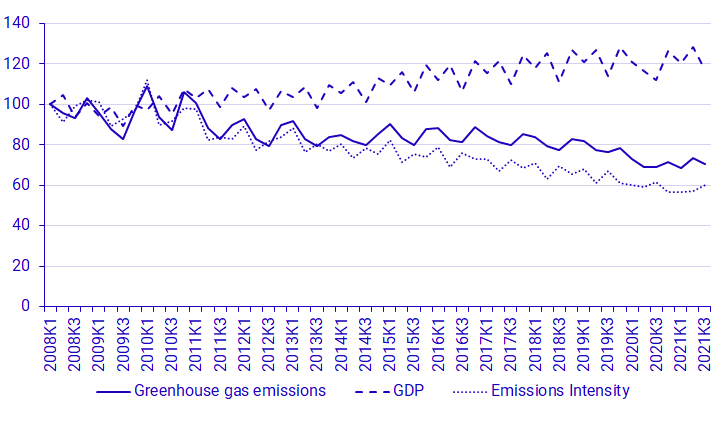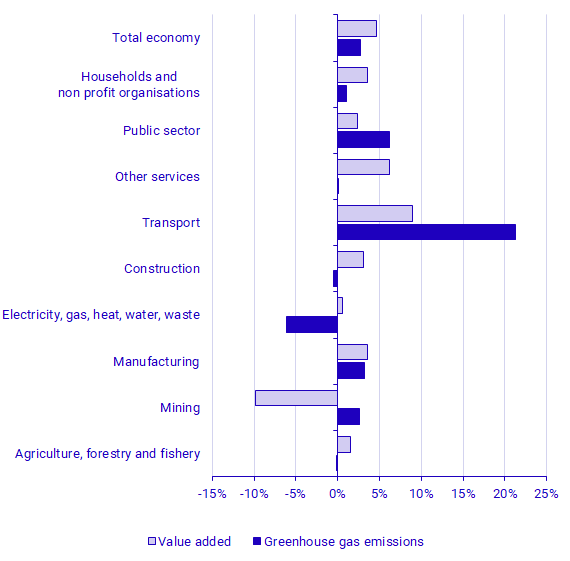Environmental Accounts – Emissions to air Q3 2021
Greenhouse gas emissions from Sweden’s economy increased
Statistical news from Statistics Sweden 2022-02-02 8.00
Greenhouse gas emissions from Sweden’s economy increased by 3 percent in the third quarter of 2021 compared with the same quarter in 2020. This is due to increased emissions in the transport sector, in particular from aviation.
Statistics on greenhouse gas and other air emissions from Sweden’s economy for the third quarter of 2021 are now available from Statistics Sweden’s Environmental Accounts. These statistics are classified by economic activity and include emissions from all Swedish economic actors, including households.
In the third quarter of 2021, total greenhouse gas emissions from Sweden’s economy amounted to 12.4 million tonnes of carbon dioxide equivalents. This is an increase of 2.7 percent compared with the corresponding quarter in 2020. Sweden’s GDP increased over the same period by 4.7 percent.
The economy’s greenhouse gas intensity, that is greenhouse gas emissions per Swedish krona of production in the economy, continued to decrease in the third quarter of 2021.

Source: Statistics Sweden.
Greenhouse gas emissions increased in the transport sector
Greenhouse gas emissions increased in many sectors in the third quarter of 2021 compared with the same period in 2020. The largest increase was noted in the transport sector, where emissions in the third quarter of 2021 were 21 percent higher than in the corresponding quarter in 2020. Within the transport sector, the increase was particularly significant for aviation, which can be attributed to reduced aviation during the third quarter of 2020 due to COVID-19. From an economic perspective, value added in the transport sector increased by 9 percent in the third quarter 2021 compared with the same period in 2020.
Noticeable increases in emissions can be seen across multiple sectors. In the energy sector, however, greenhouse gas emissions decreased by 6 percent in the third quarter of 2021, while value added increased by 1 percent. The reduction in emissions can be attributed to differences in fuel usage within the energy sector when comparing quarter 3 in 2021 and 2020. Although the level of emissions has increased in most sectors in the third quarter compared to the same period in 2020, emissions are still lower than in the corresponding period in 2019.

Source: Statistics Sweden.
| NACE 2007 industry | Greenhouse gas emissions | Value Added | |||||
|---|---|---|---|---|---|---|---|
| 2021Q3 | Change compared to samer quarter 2020 | 2021Q3 | Change compared to same quarter 2020 | ||||
| Agriculture, forestry and fishery | 2 258 | ‑1 | ‑0.1% | 18 081 | 262 | 1.5% | |
| Mining | 298 | 8 | 2.6% | 6 818 | ‑745 | ‑9.9% | |
| Manufacturing | 3 255 | 102 | 3.2% | 151 141 | 5 199 | 3.6% | |
| Electricity, gas, heat, water, waste | 1 270 | ‑82 | ‑6.1% | 24 091 | 148 | 0.6% | |
| Construction | 498 | ‑2 | ‑0.5% | 65 549 | 1 975 | 3.1% | |
| Transport | 1 550 | 272 | 21.3% | 44 634 | 3 641 | 8.9% | |
| Other services | 874 | 1 | 0.1% | 563 307 | 32 920 | 6.2% | |
| Public sector | 151 | 9 | 6.1% | 200 367 | 4 615 | 2.4% | |
| Households and non-profit institutions [1] | 2 293 | 23 | 1.0% | 14 175 | 480 | 3.5% | |
| Total economy | 12 447 | 328 | 2.7% | 1 225 973 | 54 814 | 4.7% | |
[1] Only non-profit institutions provide value added. Source: Statistics Sweden. [2] GDP with a production approach.
Definitions and explanations
The System of Environmental Economic Accounting (SEEA) is constructed using the national accounts as a foundation and presents environmental and economic statistics in a common system. The SEEA makes it possible to analyse interactions between the economy and the environment. The starting point is Swedish economic actors’ environmental pressures, irrespective of where in the world they occur.
The statistics produced here use a production perspective. This means that emissions are allocated to the actor and sector that produces the emissions. Indirect emissions arising due to imports and other consumption are not included.
The statistics produced here are not used directly to measure emissions in relation to nationally and internationally agreed climate targets. Statistics with a territorial perspective are used for that purpose. More information about different perspectives for emissions accounting is available on the Swedish Environmental Protection Agency’s website (in Swedish):
Tre sätt att beräkna klimatpåverkande utsläpp (Swedish Environmental Protection Agency)
A residence adjustment is applied to adapt statistical sources with a territorial perspective used to produce these statistics to the national and environmental accounts’ economic perspective. The residence adjustment applies primarily to transport: heavy-duty road transport (primarily within H49 land transport companies, but also other industries, such as construction), water transport (H50) and air transport (H51). The residence adjustment for heavy-duty road transport is based on data on transport work (in tonne-km) for Swedish companies abroad and foreign companies in Sweden, with data from Transport Analysis (Trafikanalys). For water transport and air transport, the residence adjustment is based on data for Swedish companies’ expenditure on fuel from Statistics Sweden’s database on intermediate use in the economy, PRIOR.
Emissions and sequestration due to land use (LULUCF) and carbon dioxide capture and storage (CCS) are not included in the statistics.
Modelling assumptions for mobile emissions
For the reference periods 2008 Q1 – 2017Q4 and 2020Q1 onwards, the air emissions for non-road machinery, road transport and aviation have been calculated with the monthly fuel, gas and inventory statistics as a source. For reference periods 2018Q1 – 2019Q4 the register of reports to the Swedish Energy Agency in accordance with Sweden’s implementation of the EU’s Renewable Energy Directive (2009/28/EC) have been used to calculate the air emissions from these sources. The reason for returning to the monthly fuel, gas and inventory statistics as a source beginning 2020Q1 and onwards is that producers of these statistics assess the data for those time periods to be of high quality. Comparisons between the period 2018Q1 – 2019Q4 and other periods in the time series should therefore be done with care.
Next publishing will be
The next statistical news on quarterly emissions to air for the fourth quarter of 2021 is scheduled for May 12, 2022.
Statistical Database
More information is available in the Statistical Database
Feel free to use the facts from this statistical news but remember to state Source: Statistics Sweden.
